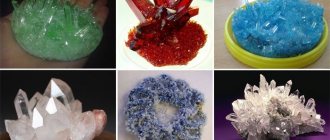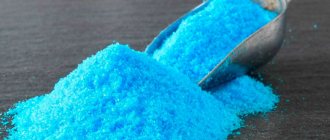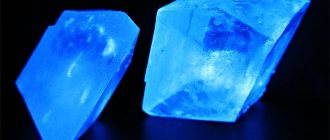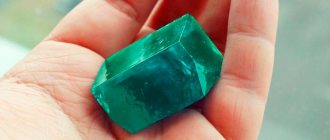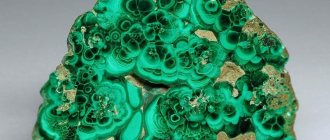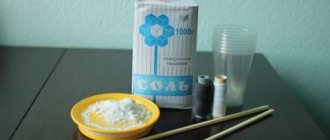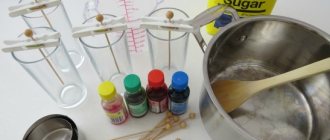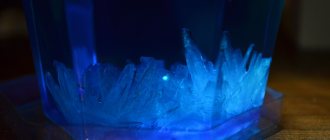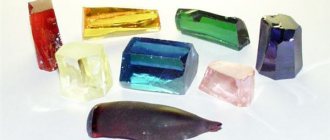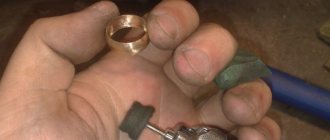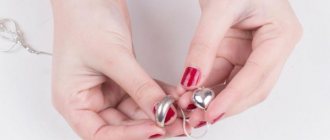Sometimes you want to do something interesting at home, for example, do a simple chemical experiment. Surely each of us is interested in how to make a crystal at home. This activity will definitely appeal not only to small children, but also to adults. Growing a crystal from salt does not require much effort, and the result will certainly please and delight everyone in the household.
Photo of how to grow crystals
Crystals, regardless of whether they are natural or artificial, amaze with their beauty, versatility and unusualness. This is why interest in growing crystals at home is increasing. They are grown in the most unusual shapes and colors, using simple ingredients such as salt, soda, citric acid, dyes, etc.
You can grow the most beautiful and unique crystal for yourself using different methods, choosing the one you like best. There are even special kits on sale for fans of home experiments, with the help of which it is possible to obtain crystals of simply incredible shapes.
Here are the photos of finished crystals that amateur chemists post online:
Instructions on how to grow crystals
Growing home crystals is a simple and exciting process if you study the rules of the experiment in advance and prepare the necessary materials. The only negative is that the crystal takes quite a long time to grow, on average it takes at least a month.
The formation of the crystal lattice, the rate of its growth, color, density - all this depends on the quality of the prepared solution, the selected dishes, and the humidity of the external environment. These details must be taken responsibly. But the first thing you need to start with is the selection of equipment.
To grow a beautiful crystal you need:
- Container for crystal. This is a kind of incubator that must comply with the rules: it should not oxidize, give off color, or deplete the smell. The best option is glass or enamel dishes. We immediately exclude metal, clay, and plastic vessels. As for size, there are no restrictions: it matters what size crystal you need.
- Stick for stirring the solution. Here again the emphasis is on the material - we choose wood or glass.
- Paper. During the growing process you will need good quality white cloths or filter paper.
- The main component for the solution. It could be table salt, sugar, soda or something else. You select this product in accordance with the selected recipe.
Although solutions from different substances are used to grow crystals, the essence of the process itself is almost identical in all recipes.
The basic growing algorithm is as follows:
- The salt or other ingredient is dissolved in hot water to form a concentrated solution.
- The seed base for the crystal (this can be a large piece of salt) is washed in water and immersed in the prepared solution.
- The container with the solution is tightly closed. After about 24 hours, remove the lid. Around 3-4 weeks a large crystal will already be noticeable.
- As soon as the top of the crystal emerges to the surface of the solution, the liquid is drained and the crystal is carefully removed from the container.
- Then the crystal is dried and kept in a place protected from water and its beauty is admired.
Coloring and storage
The resulting crystals are dried and coated with colorless varnish for better preservation. They are painted with different colored varnishes.
They will look aesthetically pleasing on a special podium, while at the same time being protected from destruction. No dyes are added to the saline solution, as they can only interfere with crystal formation.
Decorations for the New Year: decor ideas and options for decorating a house and apartment for New Year's celebrations (135 photos)- Window decoration - simple ideas and step-by-step descriptions of do-it-yourself window decoration (110 photos and videos)
Diaper cake - a step-by-step description of creating a diaper cake. 115 photos and videos of creating a gift
The question is often asked: “Is it possible to get a crystal from salt in 1 day?” We hope that the above has already been answered. However, experiment, try, but remember how much time nature spends to grow its miracle!
How to grow a crystal from vitriol at home, step-by-step instructions
If you won’t surprise anyone with a colorless crystal, then a bright blue crystal will definitely be a real surprise. To create such beauty, a special ingredient is used - copper sulfate. It produces a brighter, more natural shade of blue than food coloring.
This substance is sold in garden supply stores. It is a chemical substance, so it is not suitable for creativity with children.
If you follow the following instructions, in a couple of weeks you will grow a gorgeous dark blue crystal:
- Pour distilled water into a glass container.
- Dissolve copper sulfate powder in it until the granules stop dissolving in water.
- Dip a simple thread into the solution, fixing one edge above the container. Wait a few hours for small crystals to form on the thread.
- Choose the one you like best and leave it on the thread, and disconnect the rest and set it aside.
- Lower the thread with the crystal into the solution again, fixing the structure so that it does not touch the bottom of the container. Give the crystal a few weeks and it will grow, turning blue.
- After removing the crystal from the water, dry it and coat it with clear varnish to ensure its safety.
What you need for work
To grow crystals at home, you will need exactly what is available for their growth in nature: water and salt. The most accessible material is table salt, but in chemistry there are also other substances called salts. Both copper sulfate and sodium hyposulfite fit this definition, and they can also be used to grow wonderful crystals. Potassium permanganate, citric acid, burnt alum, beet sugar and many other substances used in everyday life are used.
The easiest option is to grow a crystal from finely ground, food-grade, non-iodized salt. The chemical formula of this salt is NaCl. Iodized salt has a more complex formula due to the inclusion of potassium or sodium iodates and iodides, so it should be left for later experiments.
Materials
In addition to salt, water is needed to grow crystals. It is best to use distilled water for the purity of the experiment. If you don’t have one in your home, it’s good to use filtered water.
You will also need a container that is inert to aggressive chemicals, because this is what a saturated salt solution can be called. The easiest way is to use a glass jar, since it is good to observe the crystal growth process through it.
The basis or frame for the crystals can be an ordinary grain or crystal of salt, a thread, a twig, or a wire. It is convenient to twist a shaped frame from a wire, on which several transparent cubes of salt will settle, the thread will similarly become overgrown with several crystals, but from one grain it is possible to get a single beautiful crystal, but there is a high risk that this base will dissolve before the crystallization process begins. This can happen if the salt solution is not saturated enough.
You can get colored salt crystals by adding food coloring to them. You can preserve your masterpiece with colorless nail polish.
Tool
Tools for growing crystals include a spoon or stick for stirring the solution, a container for preparing it, gauze for filtering, paper for blotting the finished masterpiece when it is removed from the water. It is better to choose the wire used for the frame with a varnish coating so that a chemical reaction does not occur with the metal.
How to grow a crystal from salt quickly
Crystals grow beautifully from salt, but most recipes suggest using plain table salt. It is, of course, suitable, but if you are not very patient or you need the crystal as soon as possible, we advise you to use sea salt. It will not only speed up the rate of formation of the crystal array, but also make it much stronger. But, no matter what kind of salt you take, the appearance of the crystal will remain the same - it will be large, white, slightly transparent and, of course, will resemble a strangely shaped salt.
Let's start growing a salt crystal:
- Take boiled spring or filtered water and pour it into a glass jar.
- Stir a lot of sea salt into it, and when its crystals refuse to dissolve, strain the solution through cheesecloth.
- Pour the solution back into the jar, select a large crystal of salt, tie a thread to it and lower it into the solution. Then cool the solution quickly (this will speed up the formation of small crystals on the base).
- Wait from a week to a month depending on the size of the crystal you need.
- Wipe it dry with a napkin and treat it if desired.
How to grow a crystal from sugar
Sugar crystals are not just a masterpiece of homemade creativity, but also an unusual delicacy. Just imagine becoming an edible crystal creator! Just remember to use the highest quality products.
So, let's begin:
- Prepare simple sugar, you can take food coloring if you wish, you will also need wooden sticks, water and several napkins.
- Take 2 tbsp. water and 5 tbsp. sugar, but we won’t use them right away. Heat ¼ tbsp in a saucepan. water and 2 tbsp. l. sugar - you will get a sweet syrup.
- Place a handful of sugar on a clean napkin and roll the sticks dipped in syrup in it. Make sure that the sugar sticks tightly around the entire stick, otherwise the crystal will be asymmetrical.
- Let the prepared sticks dry thoroughly so that the sugar does not crumble.
- While the pieces are drying, take a pan and add 2.5 tbsp. sugar and 2 tbsp. water, cook syrup. When all the sugar has dissolved, pour in the rest of the sugar and boil the syrup for 15 minutes.
- Take several sheets of paper in the form of a square. Pierce them with chopsticks in the middle.
- Then quickly pour the syrup into glasses, drop a few drops of multi-colored food coloring into each of them and immediately immerse the sticks in them. The workpiece should not reach the bottom or come into contact with the walls of the glass.
- Thanks to the sheet, the stick will be securely fastened, and the paper will also act as a shield that protects the syrup from penetration of the saw and moisture.
Your crystals will grow in 7-14 days and will be quite edible even for children. True, provided that natural dyes were used.
How to grow a crystal from citric acid
To grow a crystal you will need about 180 g of citric acid for every 100 g of water. Let us immediately make a reservation that the process is more complex than in the case of using salt or sugar.
Growing process:
- In water (100 ml) at a temperature of 20⁰C, dissolve citric acid (130 g). During operation, the container with the solution will need to be slightly warmed up so that the temperature is stably maintained at 20⁰C. To do this, you can use another container with hot water into which you can immerse a glass of citric acid. It is advisable to monitor the process using a thermometer.
- Then, over the course of a week, you need to add citric acid until it stops dissolving. For this, the remaining 50 g of citric acid will be enough for you. The solution will become like thick jelly, and small crystals will appear at the bottom.
- At this stage, strain the solution. Wrap one crystal with fishing line and immerse it in the seed solution.
- After 7-10 days, the crystal will reach 10-12 cm in diameter. You can pull it out, dry it and varnish it, or continue growing it.
The citric acid crystal is very sensitive to temperature changes and can crack, so it needs to be grown in stable climatic conditions.
Crystallization process
Cover the top of the jar with a napkin: no foreign impurities should get into the water solution. We place it in a permanent place without temperature changes and try not to move or shake it. Maintaining the same level in the liquid, periodically carefully add saturated sodium chlorine solution.
Visible shifts are soon observed and after a month a small polycrystal can be seen. The longer it is in solution, the larger it becomes.
At the air-water interface, crystallization occurs more intensely. Variations in the movement of such a seed make it possible to obtain salt “products” quite quickly.
How to make a single crystal from salt? Is it possible to? Experts say that a crystal close to the natural rectangular shape can be obtained quite simply.
In a package of table salt, select a large crystal and place it on the bottom of the prepared saline solution. Sea salt, being a coarser salt, is even more suitable for these purposes. To speed up the process, it is transferred to a new saturated solution after a few days. Monitor the shape and periodically scrape off excess adhesion, trying to maintain the shape.
You can see a single crystal much faster: individual tiny crystals appear at the boundary of air and water in the jar. Transparent, regular in shape, they are clearly visible under a magnifying glass.
How to grow a colored crystal
If growing crystals from food has already been successfully mastered, you can aim for a homemade ruby. Of course, it will not be real, but no less attractive and bright. The chemical substance potassium hexacyanoferrate(III), which is popularly called red blood salt, will help you obtain such a pebble. You can buy the substance without any problems in an online store or a store selling goods for the chemical industry. The crystal grows for about three weeks. At your discretion, you can grow a single crystal or a garden of many small crystals.
The process of growing homemade rubies:
- Boil 175 ml of water, dissolve 100 g of red blood salt in it. The water temperature should not be lower than 90⁰С.
- Now, if you need a single crystal, take a small crystal of ordinary salt, wrap a fishing line around it, and using a wooden stick or pencil, fix the fishing line with the crystal on the glass so that it is immersed in the solution.
- If you want to grow a garden of crystals, take a smooth stone, preferably granite, and lower it into the bottom of a bowl with a solution.
- Every day the crystal will increase in size. After three weeks, the crystal will begin to “peek out” from the water. At this point, it needs to be removed from the container, dried and coated with nail polish.
- It is important to remember that red crystals are very fragile, so you need to work with them as carefully as possible.
Ready-made sets
What remains to be added? Ready-made kits with attached instructions for growing crystals at home will also help in creating a masterpiece.
The choice is very diverse, you can buy them in stores where there are departments for creativity and development, or order them online.
The most important thing is to follow the step-by-step instructions and be patient, and then you will get the most beautiful crystal, and most importantly, it will be personal and unique!
How to grow a beautiful crystal
You can quickly grow a beautiful, regular-shaped crystal from aluminum alum. If you don’t know what it is, we’ll clarify: it’s a drug (double salts) to stop external bleeding and relieve the inflammatory process. It is sold at the pharmacy and costs a couple of rubles.
The process is quite simple:
- First, buy the necessary drug at the pharmacy. It looks like this:
- Boil 0.5 liters of water, dissolve 6 tbsp in it. l. alum.
- Now all that remains is to wait. The main thing is that until the crystals grow, do not disturb them: do not stir the solution, do not shake the container.
- In a week the crystals will grow noticeably:
- Now select a seed crystal, make a hole in it, fix the thread, the other end of which is wound to the stick.
- Dip the base crystal into the solution and wait 1-2 weeks. Its octahedral shape will remain the same, but the size of the crystal will increase significantly.
- You will get this exclusive pendant:
How to grow a crystal on a string
To grow crystals on a string you will need baking soda. Before starting the process, make sure that all working surfaces are clean, since even the smallest speck can ruin all your efforts. To work, you will need two glass glasses, a pack of soda, wool thread, and boiling water.
Soda crystals on a string - growing:
- Fill the prepared glasses halfway with boiling water. Send 6 tsp to each of them. soda
- When the soda dissolves, add another 3 tsp. powder and so on until it stops dissolving.
- Take a thread 35 cm long and secure it with a paper clip at its ends. Place glasses with soda solution in one row, placing a saucer between them, immerse the ends of the thread in the glasses.
- The thread should sag a little, but not come into contact with the saucer.
- The solution will gradually spread along the woolen thread, the moisture will evaporate and the soda will form crystals. After five days, active crystal growth will begin.
- In three weeks you will have a crystal necklace on a string.
rasper
In general, in chemistry lessons many were shown the experience of growing a crystal. So let's try to grow it ourselves!
Website: www.webinstruktor.blogspot.com
This time the instructions will be about how to grow crystals at home. This will not require much effort, but in the end you will get very attractive trinkets, which, by the way, can be used as decorations for the Christmas tree. Before you begin production, you need to acquire soluble colored salts. For example, you can find nickel sulfate.
Or you can use nickel dichloride.
After the main ingredient of the future crystal has been found, take a clean glass and fill it with distilled water.
And begin to gradually dissolve the salt in the water.
By the way, when heated, salt dissolves better, faster and more.
In this case, you can combine salts.
Then continue heating the solution and adding salt.
Bring the solution to a boil and continue adding salt.
Add until the salt stops dissolving in the solution. On average, 100g of water takes 250g of nickel sulfate salt
Next, remove the glass with the solution from heating and remove all unnecessary items from it.
Immediately after this, lower a string into the glass, on which crystals will form.
If the solution is cooled quickly, the crystals will also grow quickly, but their shape may be irregular.
If the solution is cooled slowly, the shape of the crystals will be correct.
That's all. As you can see, growing crystals with your own hands is quite simple.
To make the instructions completely complete, I also offer you a video on the same topic. Although it is in English and a different ingredient was used, it seems to me that you will understand everything.
Also, in other words.
Growing crystals. Salt crystals
WHAT YOU NEED TO KNOW! To grow a crystal, it is useful to know what processes control its growth;
why different substances give crystals of different shapes, and some do not form crystals at all; what needs to be done to make the crystals big and beautiful. If crystallization proceeds very slowly, one large crystal is obtained, if quickly, many small crystals are obtained. Substances consisting of one crystal are called monocrystalline (for example, diamond), and substances consisting of many small ones are called polycrystalline (such as metals and many other substances). Crystals are grown in different ways. For example, cooling a saturated solution. As the temperature decreases, they are said to precipitate. First, tiny crystal nuclei appear in the solution and on the walls of the vessel. When cooling is slow and there are no solid impurities in the solution (say, dust), few nuclei are formed, and they gradually turn into beautiful crystals of regular shape. With rapid cooling, many crystallization centers appear, and the process itself becomes more active. In this case, you won’t get the right crystals, because many rapidly growing crystals interfere with each other just like several parquet floor workers working in one room. Crystals can be grown in another way - by gradually removing water from a saturated solution. And in this case, the slower the water is removed, the better the crystals are obtained. You can leave an open vessel with a solution at room temperature for a long time - the water will evaporate slowly (especially if you put a sheet of paper on top, which will also protect the solution from dust). The growing crystal can either be suspended in a saturated solution on a thin strong thread, or placed to the bottom of the vessel. In the latter case, the crystal must be periodically turned to the other side. As the water evaporates, fresh solution should be added to the vessel. Even if the original crystal had an irregular shape, sooner or later it will correct all the defects and take on the shape characteristic of the given substance, for example, it will turn into an octahedron if it is a crystal of chromium-potassium alum. Growing crystals is an interesting and entertaining process, but it requires a careful and careful approach to your work. From time to time, the crystallizer needs to be cleaned: drain the solution and remove small crystals that have grown on the main crystallizer, as well as on the walls and bottom of the vessel. Theoretically, the size of the crystal that can be grown in this way is unlimited. There are known cases when enthusiasts received crystals of such size that they could only be lifted with the help of their comrades. If a grown alum crystal is left open in dry air, it will gradually lose the water it contains and turn into an inconspicuous gray powder. To protect the crystal from destruction, it can be coated with colorless varnish. Let's grow salt crystals . You know that the growth of some crystals requires specific conditions: high pressure, vacuum, temperature. We will grow crystals of salt and metals that do not require such harsh conditions.
Growing table salt crystals
Growing table salt crystals is a process that does not require any special chemicals. The salt crystals you have at home are table salt, table salt, or rock salt (all the same). NaCl table salt crystals are colorless transparent cubes. Let's begin. Dilute the solution of table salt as follows: pour water into a container (for example a glass) and place it in a pan with warm water (no more than 50°C - 60°C). Pour table salt into a glass and leave for 5 minutes, stirring first. During this time, the glass of water will heat up and the salt will dissolve. It is advisable that the water temperature does not drop yet. Then add more salt and stir again. Repeat this step until the salt no longer dissolves and settles to the bottom of the glass. We have a saturated salt solution. Pour it into a clean container of the same volume, getting rid of excess salt at the bottom. Choose any larger crystal of table salt you like and place it at the bottom of a glass with a saturated solution. You can tie the crystal by a thread and hang it so that it does not touch the walls of the glass. Now we need to wait. After just a couple of days, you can notice significant growth for the crystal. Every day it will increase. And if you do the same thing again (prepare a saturated salt solution and drop this crystal into it), then it will grow much faster (remove the crystal and use the already prepared solution, adding water and the required portion of table salt to it) Remember that the solution should be saturated, that is, when preparing the solution, salt should always remain at the bottom of the glass (just in case). For information: approximately 35g of table salt can dissolve in 100g of water at a temperature of 20°C. With increasing temperature, the solubility of salt increases. This is how table salt crystals are grown (or salt crystals, the shape and color of which you prefer)
Growing copper sulfate crystals
Growing copper sulfate crystals is done in the same way as growing table salt crystals . Blue diamond-shaped copper sulfate crystals are grown in exactly the same way: first, a saturated salt solution is prepared, then the salt crystal you like (a small crystal of copper sulfate) is dropped into this solution.
If you decide not to pour the solution from the container in which it was prepared, then you need to hang the crystal so that it does not touch other crystals remaining at the bottom! Crystals are grown not only from solutions, but also from molten salts. A striking example is yellow opaque sulfur crystals, shaped like a rhombus or elongated prisms. But I especially don’t recommend working with sulfur. The gas produced during its evaporation is harmful to health. The growth of individual crystal faces can be avoided. To do this, these edges must be applied with a solution of Vaseline or fat. Growing copper crystals :
Now let's grow red copper crystals . We need copper sulfate, table salt, a steel plate in the shape of the section of the container (slightly smaller perimeter. You can use steel filings or buttons), where copper crystals will grow, and a circle of blotting paper in the shape of the section. So, put a little copper sulfate at the bottom of the bottle (preferably evenly over the area). Sprinkle table salt on top and cover the whole thing with a cut out circle of paper. Place an iron plate on it (or fill it with steel filings). All this together must be poured with a saturated solution of table salt (we prepared such a solution when growing a crystal of table salt). Leave the container for about a week. During this time, needle-shaped red copper crystals will grow. When growing crystals, try not to move the container with the crystal, and it is also undesirable to remove the crystal from the solution.
It is possible to grow multi-layered multi-colored salt crystals. They are obtained by preparing solutions of alum (double salts of sulfuric acid) and alternately transferring the grown crystal from one solution to another.
Try growing potassium permanganate crystals (dark purple, diamond-shaped crystals). Solubility of potassium permanganate in water (at 20 o C, about 6.5 grams of potassium permanganate crystals dissolve in 100 grams of water, that is, approximately 3 cm3)
Crystals can be grown from multi-colored compounds. Alum is a double metal salt formed by dissolving metals in sulfuric acid. If you mix hot concentrated solutions of aluminum sulfates Al2(SO4)3 and potassium K2(SO4), and cool the resulting solution, then alum will begin to crystallize from it - double potassium and aluminum sulfate 2KAl(SO4)2•12H2O. Alum dissolves in water as follows: 5.9 g per 100 g of water at 20 ° C, but already 109 g at 90 ° C in terms of anhydrous salt. When stored in air, alum salt crystals erode. At a temperature of 92.5 °C, alum salt crystals melt in their water of crystallization, and when heated to 120 °C they dehydrate, turning into burnt alum, which decomposes only at temperatures above 700 °C. The water molecules that make up alum crystals are chemically bonded to potassium and aluminum ions, so alum salt crystals have a formula that is more correctly written as a complex salt [K(H2O)6][Al(H2O)6](SO4)2 .
Liquid crystals are substances that behave both as liquids and as solids. Molecules in liquid crystals, on the one hand, are quite mobile, on the other hand, they are arranged regularly, forming something like a crystalline structure (one-dimensional or two-dimensional). Often, even with slight heating, the correct arrangement of molecules is disrupted, and the liquid crystal becomes an ordinary liquid. On the contrary, at low enough temperatures, liquid crystals freeze, turning into solids. The regular arrangement of molecules in liquid crystals determines their special optical properties. The properties of liquid crystals can be controlled by exposing them to a magnetic or electric field. It is used in LCD displays on watches, calculators, computers and late-model televisions.
So, we will divide the process of growing crystals into main stages: Stage 1: Dissolve the salt from which the crystal will grow in heated water (it is necessary to warm it up so that the salt dissolves a little more than it can dissolve at room temperature). Dissolve the salt until you are sure that the salt no longer dissolves (the solution is saturated!) Stage 2: Pour the saturated solution into another container where crystals can be grown (taking into account that the crystal will increase). At this stage, make sure that the solution does not cool too much. Stage 3: Tie a crystal of salt to a thread, tie the thread, for example, to a match and place the match on the edges of a glass (container) where the saturated solution is poured (if you have a question - Growing crystals - figure for stage 3). Dip the crystal into a saturated solution. Step 4: Transfer the container with the saturated solution and the crystal to a place where there are no drafts, vibrations and strong light (growing crystals requires compliance with these conditions). Step 5: Cover the container with the crystal with something on top (for example, paper) to prevent dust and debris from entering. Leave the solution for a couple of days. Important to remember! Growing crystals: 1. the crystal should not be removed from the solution during growth without any special reason 2. prevent debris from getting into the solution where the crystal grows 3. periodically (once a week) change or refresh the saturated solution
GOOD LUCK!
How to grow a crystal from potassium permanganate
Diamond-shaped crystals of a beautiful dark purple hue grow from potassium permanganate. The growing process is the same as when using salt or sugar. But the crystals turn out to be much more interesting.
How to grow:
- Take 100 ml of water. Its temperature should not be lower than 20⁰С.
- Dissolve 6-7 g of potassium permanganate in this amount.
- When the solution becomes homogeneous, drop a salt crystal fixed on a fishing line into it.
- Now, as usual, wait a few weeks and watch the purple crystal grow.
How to grow green crystal
Knowing the basics of chemistry, it is not difficult to grow a home crystal of an exclusive green color. Of course, the easiest way is to buy a special set in a store, but we suggest going the other way and conducting a real experiment.
Growing:
- In the Garden and City store, buy Ammophos fertilizer based on ammonium dihydrogen phosphate. This substance will be the seed for growing a large crystal.
- Take a small ball of foam and wrap it with wool thread, like a ball.
- Sprinkle the ball with Ammophos powder so that large crystals grow. Drop the ball into an empty glass.
- Add 40 g of Ammophos and 10 g of green food coloring to another glass, pour 50 g of boiling water, mix everything and pour into a glass with a ball.
- It is important to pour the liquid along the edge of the container so as not to wash off the Ammophos solution from our ball. You need to fill the glass ¾ full because the ball will float to the surface (this is an important condition).
- Now make a cylinder from an A4 paper sheet, put it on a glass, and cover the structure with a napkin on top.
- Already on the fifth day you will grow an excellent crystal.
Growing crystals at home will be something special for each of you. Some will become interested in an unusual hobby, collecting their crystal collection, some will have fun with their children, and some will improve their knowledge of chemistry. But, in any case, you will have an educational time. Happy experimenting!
Instructions for growing at home
Growing crystals at home is a simple, entertaining procedure, provided that you master the basic requirements of such experiments and prepare the necessary items.
Let's determine what you need to grow crystals with your own hands:
- Melt sugar or other component in heated water until it becomes a dense liquid.
- Rinse the crystalline seed (a piece of sugar, salt) in water and place it in the previously prepared liquid.
- Close the container tightly and open it after a day. A month later we will see an impressive crystal
- The solution is drained when the top reaches the surface, taken out of the container used very carefully, trying not to damage the crystal
- Dry and store in a place, preferably dry. We enjoy the result of the work and the knowledge gained.
